Living pictures are a really cool type of animated GIF that you can create with Animation Studio. Rather than just being a video converted to GIF, where every part of every frame moves, these images animate only selected portions of the frame to give the illusion that a still image is moving.
These are the same kind of images you might see hanging on the walls in a wizard school or on a wizard newspaper, if you know what we mean. :)
There are two things that make living pictures so interesting:
- Smooth looping, which makes the motion go on forever.
- The unreal portrayal of moving objects in the same frame as objects frozen in time.
Choosing a Video to Be Made Into a Living Picture
The most important part of building a stunning living picture is starting with the proper video. Here are a few tips to help you pick the right starting point.
Good Subject Matter
The point isn't to just have a looping video, or you'd just create an animated GIF from video. The purpose of a living picture is to give an otherwise still image movement. You can simply take a still view of something and subtly animate one portion, like this waterfall.
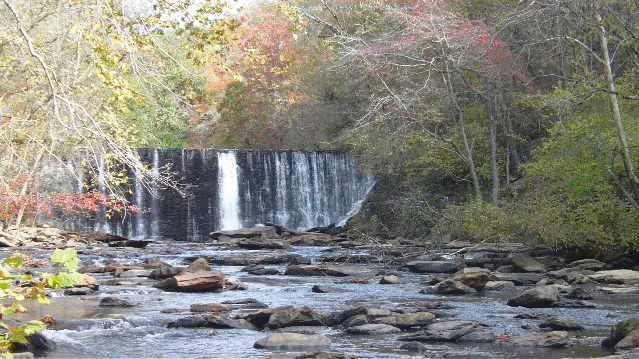
However, it can be fun to create motion in one part of the frame while holding things that should be moving completely still. These "unreal" images are what captures attention and makes people think about what they're looking at. For example, this elderly woman is frozen in time crossing the street while the crosswalk sign blinks.
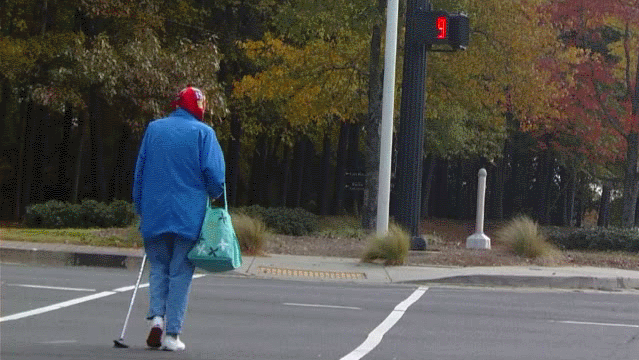
Repetetive Motion
Remember that you want the animation to loop flawlessly! As a result, anything with a repetetive motion will do. This includes blinking lights, flowing water, a pendulum swinging, a fan spinning, a flame flickering, and anything else that begins and ends in one spot. The police car and the school zone traffic light in the following image are good examples of repetetive motion.

Of course, you can also choose something that's not always in the frame as well. In the following image, cars pass by shop windows and cast their reflections upon them. The motion moves in one direction, but because the moving parts enter and exit the frame, it makes for good repetetive motion, too.
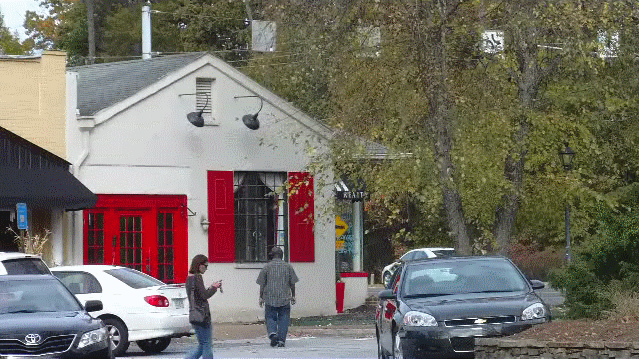
Stability
The secret to making a good living picture is stability. The camera needs to be entirely still, and the lighting shouldn't change. If the camera moves or the lighting fluctuates during filming, it'll ruin the illusion of your finished animation.
Here's an example of what happens when the camera's not totally still:
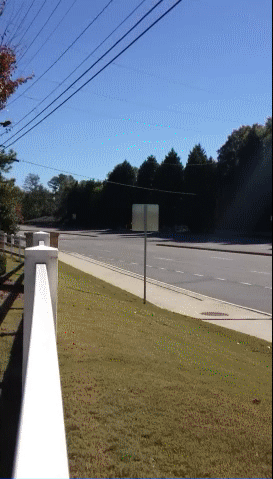
You can see the animated portion of the frame moving in a weird way if you look closely. The fence post on the left grows and jumps back into place. This is because the camera tipped forward slowly during filming.
So how do you solve this issue? First of all, if you can attach your camera to a tripod, do it! This will save you some serious headaches. If you are shooting with an iPhone like in the image above and don't have a tripod mount, or are using some other type of unmountable camera, you need to be very careful when filming. Even the slightest movement of the camera can ruin the illusion. Try resting the phone against something stable, like a table or wall; usually, just using your own leg isn't quite good enough.
When it comes to Indoor lighting, your task is usually simple, because lights rarely move inside. But outside, lighting can change because things get in the way of the sun. Shooting while clouds aren't anywhere near the sun is a good idea. We filmed Nacho in direct sunlight and the resulting movement in his shadow is very stable:
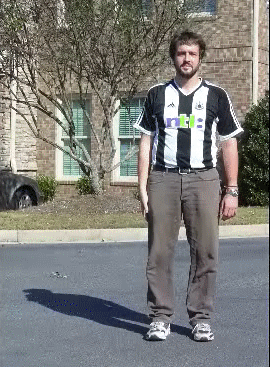
How to Create a Living Picture with Animation Studio
Now that you understand what's so great about these nifty animations and how to prep for them, it's time to actually make one!
Get started by clicking the New toolbar button and choosing Living Picture Project. This opens the Create Living Picture wizard.
Step 1: Introduction to Living Pictures
When the wizard opens, you'll see an introduction screen that gives you a brief overview of what you are about to do. Here's the basic rundown:
- Start with a good, stable video.
- Make video adjustments, if desired.
- Crop the portion of the video that will be appear in the final animation.
- Choose one frame from the video to be the background, or still frame.
- Select the portion of the video that will animate.
- Select the range of the video that will loop in the animated portion.
- Build your animation!
Also included in the intro is an example of what a Living Picture looks like. We've included the source video for this image so you can follow this guide and build it yourself.
- Download the video here
- Double-click the downloaded file to unzip the video
You're ready to go. Click Next and let's make a Living Picture!
Step 2: Choose Your Video
Click the Open button and find the video on your computer.
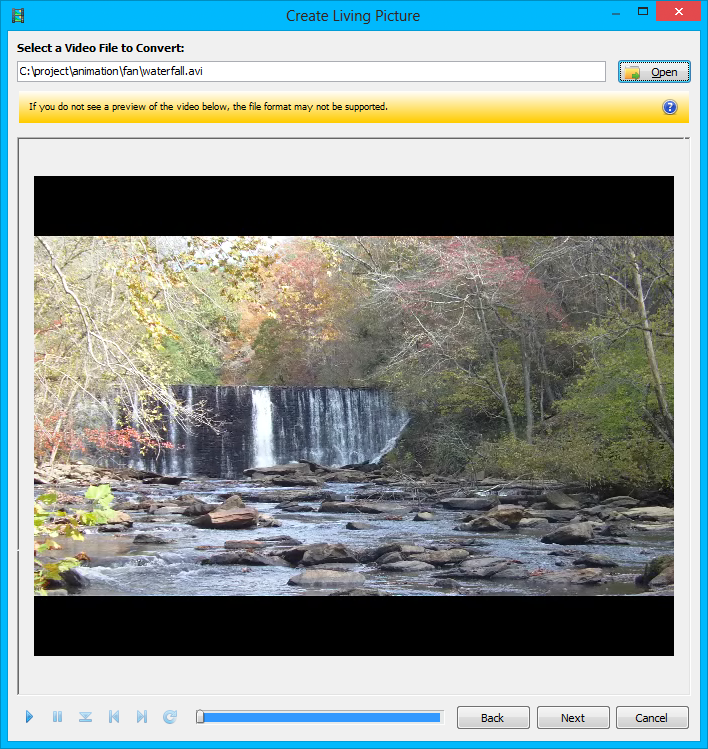
You can click the Play button in the lower left corner to preview the video to make sure it's the right one. When you're ready to move on, click Next.
Step 3: Make Video Adjustments (Optional)
On this screen, you can move the sliders to adjust the way your video looks. This can be helpful if your video just needs some small tweaks.
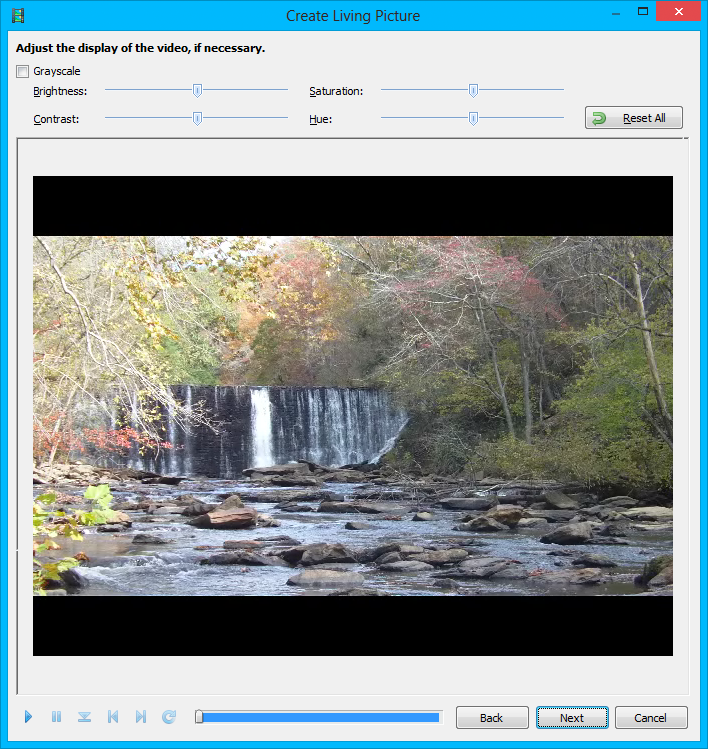
There are 6 tools here that you can use to adjust your video:
- Grayscale: Check this box to make your video black and white.
- Brightness: Make your video brighter or darker.
- Contrast: Increase or decrease the difference between bright and dark parts of your video.
- Saturation: Increase or decrease the richness of color in your video.
- Hue: Change the colors in your video.
- Reset All: Change each setting back to its default value.
You may not need to use any of these tools, but they can be be very useful. For example, we can increase the contrast of our video to reduce the "hazy" appearance:
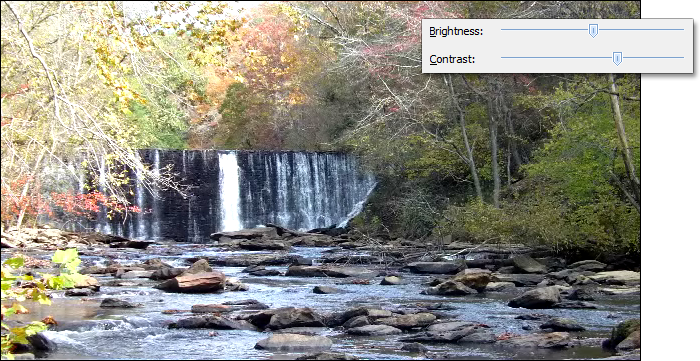
And then we change the hue of the video slightly to give an old photo effect:
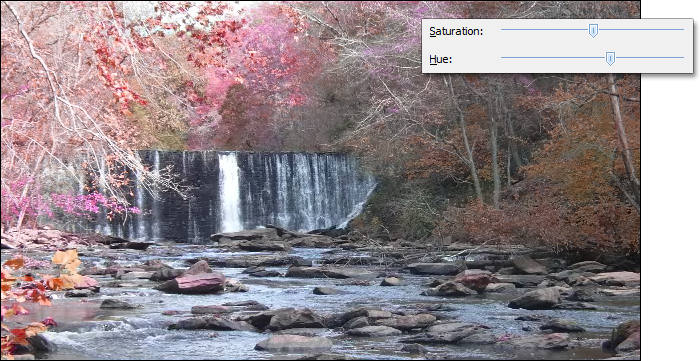
When you're done adjusting your video, click Next.
Step 4: Crop the Video
Though this step is also optional, it's likely that you'll need to do it every time.
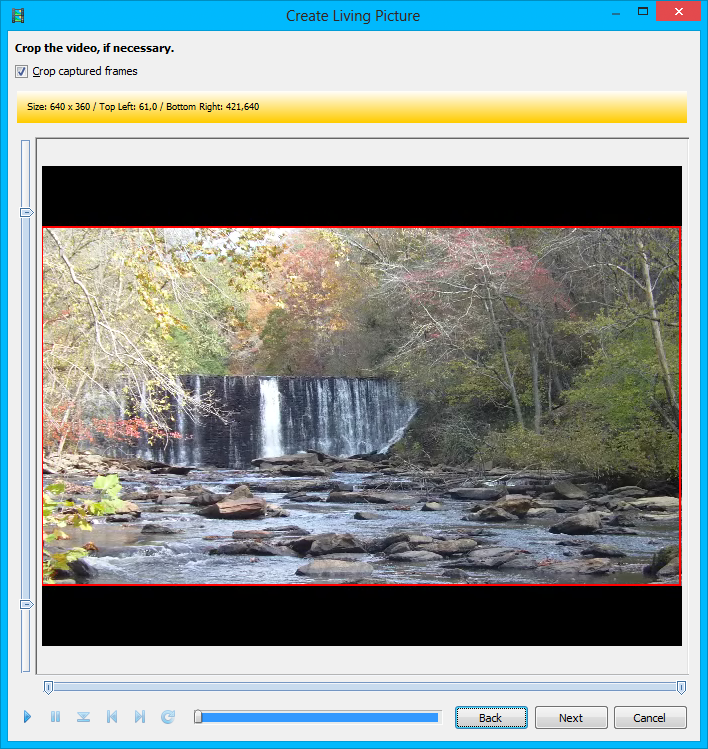
If you need to crop, check the box next to Crop captured frames and drag the sliders to the left and bottom of the video. A red border will be drawn around the portion of the frame that will be captured.
In our example, we want the full width of the frame, so we don't need to move those bottom sliders. But we have to get rid of those black bars above and below the video, so drag the top slider down and the bottom slider up until the red lines select only the actual video.
Note: If your video is so large that it extends outside of the wizard's view, increase the size of the window to see the red lines that show you what you're cropping.
When you're done cropping, click Next.
Step 5: Pick a Background Frame
In this step, you'll choose the one frame of the video that will remain stationary. Your animation will be layered on top of this frame.
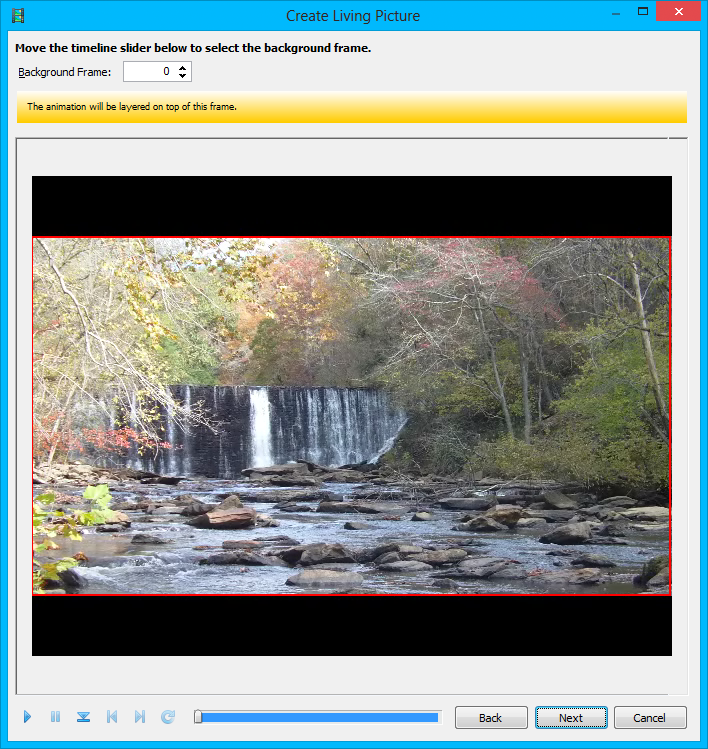
There are two ways to choose the background frame:
- Enter a number into the stepper above the video (or use the arrows to select the frame)
- Drag the playback slider below the video to the proper frame
For our example, we're going to make things easy. Simply leave it at frame 0 and click Next.
Step 6: Select the Portion to Be Animated
In this step you need to draw a border around the portion of the video that will animate in the finished product.
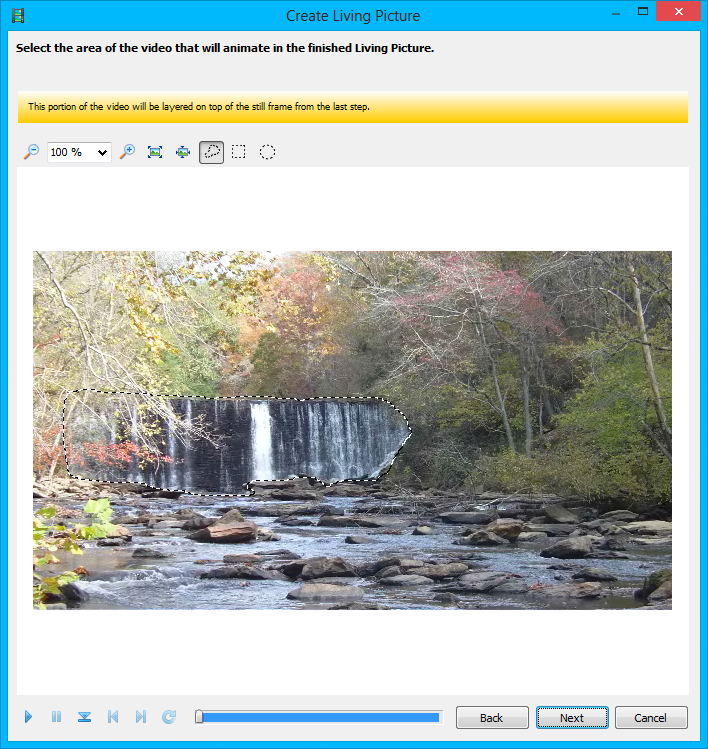
There are two sets of tools above the video preview that will help you make the right selection:
View Tools:
- Zoom Out: Make the preview smaller to fit more on the screen
- View Drop-Down: Choose a specific view percentage or fit the window
- Zoom In: Make the preview larger to see more detail
- Fit Window: Make the preview the exact dimensions of the window
- Show at 100%: Show the preview at the same scale as the finished animation
Selection Tools:
- Select Free Form: Draw a selection using a pencil-like freehand style
- Select Rectangle: Draw a rectangular selection
- Select Circle: Draw a circular selection
It may be helpful to use the transporter tools at the bottom. Click Play to preview the video in motion, or click Show background frame to move the preview to the selected background frame.
If you need to make multiple selections, hold down the Shift key while drawing new selections.
When you've made your selection, click Next. You can always go back and change any step.
Step 7: Select the Range of Video to Be Animated
In this step, you need to drag the sliders below the video preview to choose the start and end points of the portion of the video that will loop in the final animation.
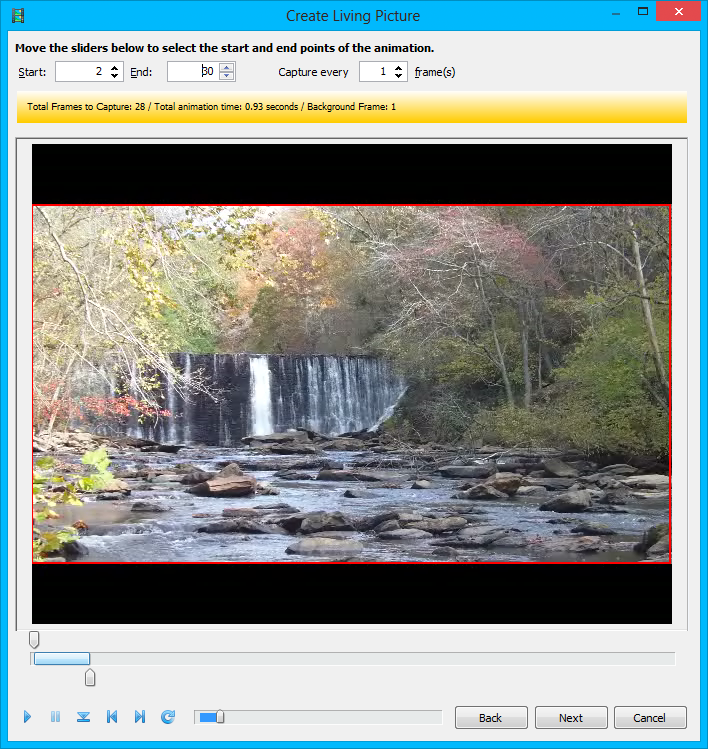
See those two tabs under the video preview, and the blue section highlighted in-between? This is the part of the video that will animate.
By default, the left tab is set to the frame after the background frame. So if you chose frame 340 as your background frame, the initial value for the Start slider will be 341.
There are three steppers above the video preview:
- Start: The first frame of the loop
- End: The last frame of the loop
- Capture every X frame(s): The interval used for frame capturing (if this is set to 3, every third frame will be captured)
Oh look, more transport tools are available now! Here's a description of all the tools in the bottom left corner:
- Play: Play a preview of the full video
- Pause: Stops all preview playback
- Show background frame: Displays the selected background frame in the video preview
- Show first frame of loop: Displays the Start frame in the video preview
- Show last frame of loop: Displays the End frame in the video preview
- Play selected range: Loops the frames selected above in the video preview
These last four tools are designed to help you make flawless loops. By clicking between the background frame and end frame, you can see the difference between the two. This can help you pick the perfect end frame for your animation so that the motion loops smoothly and you have a continuous, flawless animation.
When your range is selected, click Next.
Step 8: Build your animation!
This last step will prompt you to build your animation. Click Build! (Even after building, you can click the Back button to make changes.)
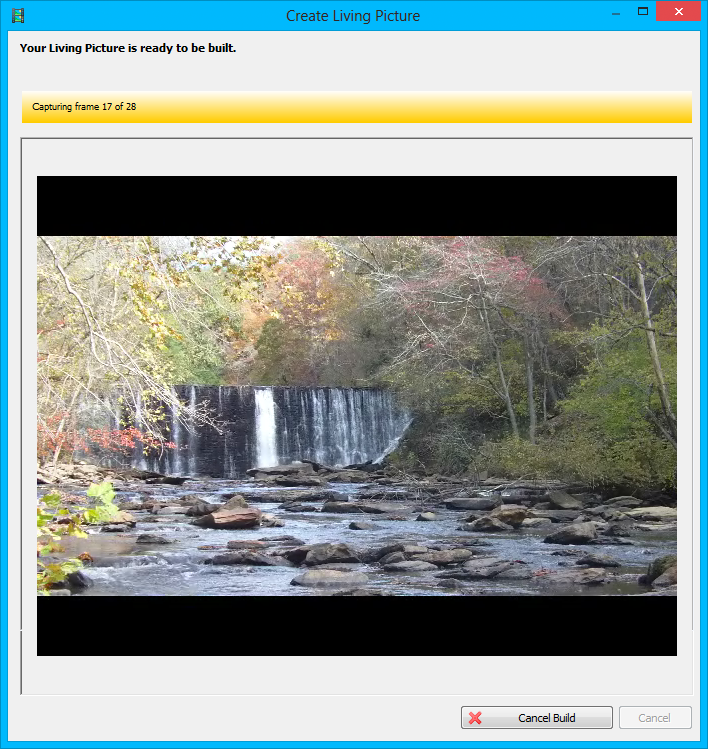
Animation Studio will compile the video from all the selections you made in the previous 7 steps and then show you a preview of the animation you've created. If you're not happy with the way it looks, click the Back button and make some changes. Otherwise, click Finish to import all those frames into animation studio.
Congratulations, you made a Living Picture! Don't forget to save it. :)

